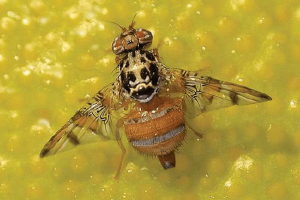Host plants
Mediterranean fruit fly is highly polyphagous, having been recorded from more than 300 species of cultivated and wild plants, whereas Natal fruit fly, with its more limited distribution, is known from more than 100 hosts. Cultivated hosts of these two species in southern Africa include grapevine and berries, all deciduous fruits, citrus and various subtropical crops such as avocado, guava, litchi, mango and coffee (De Meyer et al. 2002).
Damage
Both species oviposit in ripening fruit so damage results from fruit infestation by larvae (illustrated) and can cause the fruit to drop and to rot, or result in the fruit being rejected for export. Sometimes fruit flies will probe the fruit with their ovipositor but will not lay eggs. These blind stings will usually result in sour rot and the loss of the fruit as well.
Being internal fruit pests, both fruit flies are considered quarantine pests and infested fruit will be rejected for export. Due to medfly being present in the Mediterranean, its pest status is not as serious as of that Natal fly for European markets. However, cold disinfestation treatments are required for all fruit exported to the USA, Japan, China and several other markets because both the fruit fly species are present in southern Africa.
Life History
After mating, females seek out ripening fruit and lay their eggs in clumps in the rind of the fruit. Many newly hatched larvae die, probably because of the oil in the citrus skin or because of gum formation. Those that survive, burrow into the pulp where they feed. Mature larvae leave the fruit and usually pupate shallowly in the soil.
The life cycle of both fruit fly species is very similar and is temperature dependent. An ideal temperature for both is 26 ˚C, at which the egg stage takes about two days; the three larval stages are completed in six days and the pupal stage in about nine days. However, medfly adult females mate and oviposit only three days after eclosion, while Natal fly females only oviposit after six days. The egg-to-egg life cycle duration at 26 ˚C is approximately three weeks.
Both fruit flies occur on citrus and other hosts throughout the year, during which there can be up to 15 generations, depending on climatic conditions. They overwinter as adults, seeking shelter in evergreen plants. During this period egg laying is suspended. Populations peak during late summer and autumn, coinciding with the end of the season for deciduous and wild fruit. They then migrate on large scale to citrus, making early cultivars, such as Satsuma mandarins and navel oranges particularly prone to fruit fly attack.
Natural enemies
Little is known about the parasitoids of these fruit flies in southern Africa. As parasitoids only attack eggs or larvae when they are already in the fruit, they do not provide much benefit for commercial agriculture other than reducing the population in indigenous hosts.
Management
Both fruit flies can be monitored by using the same lures: Capilure® or enriched ginger oil for males and Questlure® or BioLure® for females. Sanitation, or the removal of infested fruit from trees and under trees, is an essential part of management and should take place once a week. This fruit should be buried in the ground, at least 30 cm deep or chopped up finely. Flies are controlled using bait stations, so that little or no pesticide is applied to fruit shortly before harvest. These control practices need to be implemented when the fruit starts to colour. Thresholds are available for some of the lures mentioned above depending on the trap type and crop.







